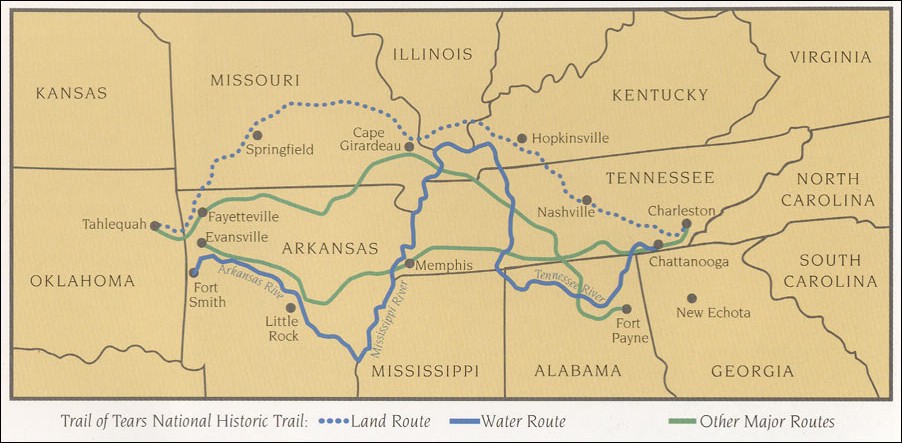
Appalachia

The first known appearance of a variant on the name of Appalachia comes from a 1562 map of the Western Hemisphere By Diego Gutiérrez (U.S. Library of Congress) [Public domain], via Wikimedia Commons.
Vocabulary
- Culture
- Migration
- Dialect
- Emigration
- Immigration
- Oral history
- Ballad
Trail of Tears

Map of the Trail of Tears from the National Park Service (download full size JPG)
John Henry Ballads
- Legendary figures of Appalachia were often times immortalized in song. One of the most well known is the Legend of John Henry. Listen to a collection of John Henry ballads below.
- John Henry - Arlie And Ora Watson
- John Henry - Fred And Kenneth Price And Clint Howard
- John Henry - Stanley Hicks
- John Henry - Tab Ward And L.C. Trivette
- John Henry - Tab Ward And Ran Shook
Chang and Eng Bunker
An interesting immigration tale is that of Chang and Eng Bunker, brothers born in 1911 in Taiwan. These brothers were the first documented case of conjoined twins and became known all over the world as "Siamese twins." They left their country to tour in many side shows and festivals, predominantly with Barnum and Bailey Circus Co. Though it was a tough life they made a lot of money and at the age of 27 in the year 1938 they retired to the foothills of North Carolina in Wilkes County, later moving to Surry County after visiting the area on a hunting and fishing trip.

Chang and Eng Bunker, "The image featured above is an original watercolor on ivory depicting the twins, and it was painted by an unidentified French or Dutch artist in Paris between December, 1835 and March, 1836. It is currently in the holdings of the North Carolina Collection Gallery."
Recent Immigration
From 1970-2004 the Latino population of North Carolina alone has increased by 1066%, this has created a changing landscape in Appalachia (Margolies, 2009, p. 116). This shift is represented by the migrants' music which strengthens their identity and the blended cultural landscape (Margolies, 2009, p. 118). While Mexican styles like norteño and mariachi serve as a representation of Mexican, they are being adapted by migrant musicians to their new culture. Musicians are using local place-names in their compositions, and mariachis travelling throughout Appalachia and the Piedmont incorporate American popular songs as well as traditional Mexican songs (Margolies, 2009, p. 118-122). For example, Mt. Airy in Surry County, NC, best-known as a hotspot of old-time music and fiddlers' conventions, also hears the music of Latino festivals (Margolies, 2009, p. 114).
Beginnings
The first humans to settle the Blue Ridge were big-game hunters, who migrated around 8000 B.C.E. By 1000 B.C.E. as these people became more settled, they began practicing small-scale agriculture. The later so-called Mississippian culture practiced more intensive agriculture and built ceremonial temple mounds by 700 C.E. Excavations in Burke, Caldwell, and Wilkes Counties show evidence of a mound-building culture. Eventually different cultures developed, the dominate one in the region was the Cherokee Nation.
At their height the Cherokee nation covered a vast area with settled towns, intensive agriculture, an expansive hunting trail network, and various dialects of the Cherokee language. Story-telling was a main source of entertainment for the Cherokee, and they used Oral Histories to pass down tales and myths.
European Immigration
In 1540, the first Immigrants to arrive in Western North Carolina were Europeans who came for conquest and to emigrate from oppressive regimes in Europe. From 1759-1771 the white population of Western North Carolina doubled. Joining the Cherokee were the English, Scots-Irish, Highland Scots, Welsh, Irish, Dutch, German, and French immigrants. The immigration experience was different for everyone and a popular historical record of these experiences can be learned through listening to or reading transcriptions of their oral histories and ballads. Many immigrants used the wagon trails of the Cumberland Gap on their way to new opportunities. You can listen to several versions of the song Cumberland Gap below.
Pressure from White settlers reached its peak with the passage of Indian Removal Act of 1830. A forced treaty in which the Five Civilized Tribes: the Cherokee, Chickasaw, Choctaw, Muscogee, and Seminole, ceded, or gave, all of their Eastern lands to the federal government. The tribes were "evacuated" to western lands in what is now Oklahoma. In June of 1838 an estimated 5,000 Cherokee were forcibly removed. The second group included more than 12,000 with an estimated 4,000 deaths during the journey. This forced evacuation and the route it traveled is now known as the Trail of Tears.
Africans outnumbered all other ethnic groups coming to colonial America, most as slaves, their labor was used in land-clearing and construction, and some free blacks made their own land claims. In 1790, there were 18,224 slaves and 1,172 free blacks in the core Appalachian region (many scholarly definitions include a "core" region of 164 counties in Georgia, North Carolina, Tennessee, Kentucky, West Virginia, and Virginia).
Immigrants
Many immigrants came to the area before the Civil War. The largest groups to immigrate at this time were the Irish, German, and Chinese. This is largely due to crop failures and political revolts within their own countries. Most accounts of this time detail the hard times brought on by the Civil War which lasted from 1861-1865.
Wayfaring Stranger - Beulah Green
recorded July 22, 1946, Source: AC.114 W. Amos Abrams Papers, 1884 - 1984
Appalachian Music is American Music
Just like the history of cultures or art, there are many factors that affect the birth of a unique and identifiable style or type of music. Appalachian music is no exception. Fiona Ritchie and Douglas Orr (2014) describe Appalachian music as, "a tapestry of a cappella ballads, dances, fiddle tunes, banjo music, and sacred music" (p. 213). It is generally thought that the songs and fiddle tunes of Scots- Irish settlers formed the foundation that was built upon by many other settlers and their own unique musical traditions. Between 1717-1775 many people from the border nations of Northern Ireland, Northern England, Southern Scotland migrated to Appalachia, bringing with them each of their own stories, songs, and cultures.
Appalachia was a cultural melting pot, and the music of the region is a perfect example. Cherokee, Scottish, English, German, Welsh, Scandinavian, and African Americans brought their musical traditions to the mountains and mixed them, each giving and taking different rhythms and styles. The traditional instruments from different cultures also greatly contributed to the unique sound of Appalachian music. The banjo evolved from a gourd based instrument from West Africa called the ngoni. The German sheitholt eventually became the dulcimer, Italian Mandolins and Cherokee flutes, whistles and fiddles influenced white fiddlers (Ritchie & Douglas, 2014, p. 213).

Griots with Ngoni, Image by Jeanniot (grav.) (Bibliothèque nationale de France) [Public domain], via Wikimedia Commons
County-level Information on Migration
Citations
Margolies, D S. (2009) "Latino Migrant Music and Identity in the Borderlands of the New South". The Journal of American Culture. 32 (June 2009): 114-125
Ritchie, F., Orr, D. M., & Parton, D. (2014). Wayfaring strangers: The musical voyage from Scotland and Ulster to Appalachia. 213.